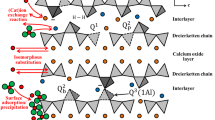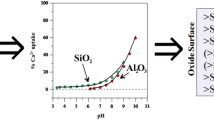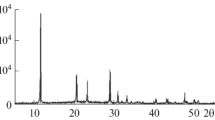Abstract
Acidified suspensions of Al-saturated kaolinite, montmorillonite, mica, illite, and biotite in 10−3 M NaNO3 were potentiometrically titrated with 0.1 N NaOH and 0.1 N HNO3 in succession in a CO2-free nitrogen atmosphere. The resulting curves were compared with those for Al(NO3)3 solutions of similar Al concentration in the supernatant solution and corrected for Al in the entrained solution in the clay.
Base titrations of Al ions adsorbed on all the minerals, except montmorillonite, showed two pH inflections separated by a buffering range. With montmorillonite, there were three pH inflections similar to those for Al in solution. The first inflections in the titration of suspensions occurred at lower pHs and were less pronounced than for Al in solution. These represent the titration of H3O+ sorbed during the pretreatment. The buffering by adsorbed Al ions is also less than that by Al in solution.
The OH− used up by adsorbed Al ions between the first and last inflections was equal to, or slightly greater than, the CEC of the minerals, except for mica where it was more than twice the CEC, because new interlayer surfaces were formed during the acid pretreatment. Acid titration curves of Al ions in the adsorbed and solution states showed hysteresis when related to the base titration curves. The use of two titration speeds (3 and 0.3 pH units/hr) only slightly affected the titration curves of the minerals suggesting that the observed effects were not caused by lack of equilibrium with added base or acid.
Резюме
Ацилированные суспензии насыщенных Аl каолинита, монтмориллонита, слюды, иллита, и биотита, в 10-3 М NaNO3 были последовательно потенциометрически титрованы с 0,1 N NaOH и 0,1 N HNO3 в азотной атмосфере, свободной от СO2. Результирующие кривые сравнивались с кривыми для растворов Al(NO3)3 с такой же концентрацией Аl как в отстоявшемся растворе и корректировались за А1 в захваченном растворе с глине.
Основные титры ионов А1, адсобированные всеми минералами, за исключением монтмориллонита, показывали два перегиба pH, разделенные буферным диапазоном. Что касается монтмориллонита, то здесь были три перегиба, подобных перегибам для А1 в растворе. Первые перегибы в титре суспензий появлялись при низких значениях pH и были менее выражены, чем перегибы для Аl в растворе. Они представляют титры Н3O+, сорбированного в течение предварительной обработки. Буферное действие адсорбированных ионов А1 также слабее по сравнению с Аl в растворе.
ОН-, использующийся адсорбированными ионами Аl между первым и последним перегибами, был равен или несколько выше катионной обменной способности минералов, за исключением слюды, где он более чем в два раза превышал его катионную обменную способность, потому что образовались новые межслойиые поверхности во время предварительной кислотной обрабртки. Кривые кислотного титрования ионов А1 в адсорбированном и растворенном состояниях показывали гистерезис, когда относились к кривым основного титрования. Использование двух скоростей титрования (3 и 0,3 pH единиц/ч только незначительно воздействует на кривые титрования минералов, показывая, что наблюдавшиеся эффекты не были вызваны отсутствием равновесия с добавленными основанием или кислотой.
Resümee
Angesäuerte Suspensionen von mit Al gesättigten Kaolinit, Montmorillonit, Glimmer, Illit, und Biotit in 10-3 M NaNO3 wurden nacheinander mit 0,1 N NaOH und 0,1 N HN03 in einer Kohlendioxyd freien Atmosphäre potentiometrisch titriert. Die resultierenden Titrationskurven wurden mit denen für AlfNOsH Lösungen mit ähnlichen Al-Konzentrationen in der überstehenden Flüßigkeit verglichen und korrigiert für Al in den eingeladenen Lösungen im Ton. Als Al-Ionen, adsorbiert auf allen Mineralien mit Ausnahme von Montmorillonit, mit Basen titriert wurden, zeigten sich zwei pH-Inflektionen, welche durch ein Pufiferbereich getrennt waren. Mit Montmorillonit gab es drei pH-Inflektionen, die denen von Al, in Lösung gleichen. Die ersten Inflektionen in der Titrationen von Suspensionen findet bei niedrigen pH Werten statt und sind weniger ausgeprägt als für Al in Lösung. Diese repräsentieren die Titration von H30+, welches während der Vorbehandlung adsorbiert wurde. Adsorbierte Al-Ionen puffern weniger als Al in Lösung. Das OH’, welches von den adsorbierten Al-Ionen zwischen den ersten und letzten Inflektionen verbraucht werden, entsprach oder war etwas höher als das CEC der Mineralien mit Ausnahme des Glimmer, für den es mehr als zweimal seines CEC war, weil neue Zwischenschichtflächen während der säurevorbehandlung geformt worden. Säuretitrationskurven von Al-Ionen im adsorbierten und Lösungszustand zeigte Hysteresis, wenn man sie auf die Alkalititrationskurven bezieht. Die Benutzung von zwei Titrationsgeschwindigkeiten (3 und 0,3 pH Einheiten/h) hatten nur wenig Einfluß auf die Titrationskurven, was andeutet, daß die beobachteten Effekte nicht durch Mangel eines Gleichgewichts mit zugefügter Base oder Säure verursacht wurden.
Résumé
Des suspensions acidifiées dans 10-3 M NaNO3 de kaolinite, de montmorillonite, de mica, d’illite, et de biotite saturés d’Al ont été potentiométriquement titrées avec 0.1 N NaOH et 0.1 N HNO3 en succession, dans une atmosphère nitrogénée sans C02. Les courbes résultantes ont été comparées à celles de solutions d’Al(NO3)3 de concentration Al semblable dans la solution surnageante et corrigées pour Al dans la solution entraînée dans l’argile. Des titrages basiques des ions Al adsorbés sur tous les minéraux sauf la montmorillonite, ont montré 2 inflexions de pH séparés par une région tampon. Pour la montmorillonite, il y avait 3 inflexions de pH semblables à celles pour l’Al en solution. Les premières inflexions dans les titrages des suspensions ont survenu à de plus bas pH et étaient moins prononçés que dans le cas de l’Al en solution. Celles-ci représentent le titrage de H30+ sorbé pendant le prétraitement. L’effet de tampon produit par les ions d’Al adsorbé est aussi moins élevé que celui d’Al en solution. L’OH utilisé entre les premières et dernières inflexions par les ions d’Al adsorbés était égal à ou un peu plus élevé que la capacité d’échange de cations (CEC) des minéraux, sauf dans le cas du mica, où il était plus de deux fois plus éleVé que son CEC parceque de nouvelles surfaces interfeuillet ont été formées pendant le prétraitement acide. Les courbes de titrage acide des ions Al dans les états adsorbés et en solution ont montré une hystérésis lorsque mis en relation avec les courbes de titrage basique. L’emploi de deux vitesses de titrage (3 et 0.3 pH unités/h) n’a affecté que très peu les courbes de titrage des minéraux suggérant que les effets observés n’étaient pas causés par un manque d’équilibre dû à l’addition de base ou d’acide.
Similar content being viewed by others
References
Bache, B. W. (1974) Soluble aluminium and calcium-aluminium exchange in relation to the pH of dilute calcium chloride suspensions of acid soils: J. Soil Sci. 25, 320–332.
Bache, B. W. and Sharp, G. S. (1976a) Characterization of mobile aluminium in acid soils: Geoderma 15, 91–101.
Bache, B. W. and Sharp, G. S. (1976b) Soluble polymeric hydroxy-aluminium ions in acid soils: J. Soil Sci. 27, 167–174.
Brown, G. and Newman, A. C. D. (1973) The reactions of soluble aluminium with montmorillonite: J. SoiI Sci. 24, 337–354.
Cabrera, F. and Talibudeen, O. (1978) The release of aluminumfrom aluminosilicate minerais. I Kinetics: Clays & Clay Minerais 26, 434–440.
Chakravarti, S. N. and Talibudeen, O. (1961) Phosphate interaction with clay minerais: Soil Sci. 92, 232–242.
Dalal, R. C. (1975) Hydrolysis products of solution and exchangeable aluminium in acidic soils: Soil Sci. 119, 127–131.
Frink, C. R. and Sawhney, B. L. (1967) Neutralization of dilute aqueous aluminium sait solutions. Soit Sci. 103, 144–148.
Low, P. F. (1955) The role of aluminium in the titration of bentonite. Soil Sci. Soc. Am. Proc. 19, 135–139.
Pyman, M. A. F., Posner, A. M., and Talibudeen, O. (1976) Hydrolysed aluminium ions on montmorillonite: Rothamsted Exp. Stn. Rep. for 1975, Part 1, 94–95.
Rich, C.I. (1970) Conductimetric andpotentiometric titration of exchangeable aluminium: Soil Sci. Soc. Am. Proc. 34, 31–38.
Schwertmann, U. and Jackson, M. L. (1963) Hydrogen-aluminium clays: A third buffer range appearing in potentiometric titration: Science 139, 1052–1053.
Schwertmann, U. and Jackson, M. L. (1964) Influence ofhydroxy aluminium ions on pH titration curves of hydronium-aluminium clays: Soil Sci. Soc. Am. Proc. 28, 179–183.
Smith, B. H. and Emerson, W. W. (1976) Exchangeable aluminium on kaolinite: Aust. J. Soil Res. 14, 43–53.
Stol, R. J., van Helden, A. K., and de Bruyn, P. L. (1976) Hydrolysis-precipitation studies of aluminium (III) solutions. 2. A kinetic study and model: J. ColloidInterface Sci. 57, 115–131.
Turner, R. C. (1968a) Conditions in solution during the formation of gibbsite in dilute aluminium sait solutions: I. Theoretical treatment of the effect of the formation of mono- and polynuclear hydroxy-aluminium ions, précipitations and crystallization on curves representing the titration of A1C13 with a base: Soil Sci. 106, 291–296.
Turner, R. C. (1968b) Conditions in solution during the formation of gibbsite in dilute aluminium sait solutions: II. Effect of length of time of reaction on the formation of polynuclear hydroxy-aluminium cations, the substitution of other anions for OH− in amorphous Al(OH)3 and the crystallization of gibbsite: Soil Sci. 106, 338–344.
Vermeulen, A. C., Geus, J. W., Stol, R. J., and de Bruyn, P. L. (1975) Hydrolysis-precipitation studies of aluminium (III) solutions: I. Titration of acidified aluminium nitrate solutions: J. Colloid Interface Sci. 51, 449–458.
de Villiers, J. M. and Jackson, M. L. (1967a) Cation exchange capacity variations with pH in soil clays: Soil Sci. Soc. Am. Proc. 31, 473–476.
de Villiers, J. M. and Jackson, M. L. (1967b) Aluminous chlorite origin of pH-dependent cation exchange capacity variations: Soil Sci. Soc. Am. Proc. 31, 614–619.
Vogel, A. I. (1961) A Text-book of Quantitative Inorganic Analysis: 3rd ed., Ch. I, Longman, London.
Author information
Authors and Affiliations
Rights and permissions
About this article
Cite this article
Cabrera, F., Talibudeen, O. The Release of Aluminum from Aluminosilicate Minerals. II. Acid-Base Potentiometric Titrations. Clays Clay Miner. 27, 113–118 (1979). https://doi.org/10.1346/CCMN.1979.0270206
Published:
Issue Date:
DOI: https://doi.org/10.1346/CCMN.1979.0270206




